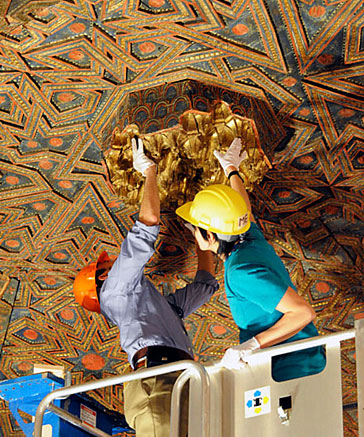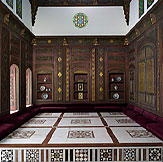The grand reopening of a suite of 15 dramatic New Galleries for the Art of the Arab Lands, Turkey, Iran, Central Asia, and Later South Asia takes place at New York’s Metropolitan Museum of Art on November 1. The greatly enlarged, freshly conceived, and completely renovated galleries will house the Metropolitan’s renowned collection of Islamic art—one of the finest and most comprehensive collections of this material in the world. Design features within the new space will highlight both the diversity and the interconnectedness of the numerous cultures represented here; multiple entryways will allow visitors to approach the new galleries—and the art displayed within—from different perspectives.
“The opening of these extraordinary new galleries underscores our mission as an encyclopedic museum and provides a unique opportunity to convey the grandeur and complexity of Islamic art and culture at a pivotal moment in world history,” stated Thomas P. Campbell, Director of the Metropolitan Museum. “In sequence, the 15 new galleries trace the course of Islamic civilization over a span of 13 centuries, from the Middle East to North Africa, Europe, and Central and South Asia. This new geographic orientation signals a revised perspective on this important collection, recognizing that the monumentality of Islam did not create a single, monolithic artistic expression, but instead connected a vast geographic expanse through centuries of change and cultural influence. The public will find galleries filled with magnificent works of art that evoke the plurality of the Islamic tradition and the vast cross-fertilization of ideas and artistic forms that has shaped our shared cultural heritage.”
Sheila Canby, the Patti Cadby Birch Curator in Charge of the Department of Islamic Art, said: “Although our galleries represent a vast territory over a long period of time, the diverse artworks shown here are nonetheless unified in several distinctive ways. Primary among these is the extensive use of Arabic script, which resulted in exceptional examples of calligraphy—often in conventional media, such as metalwork or architectural elements—and virtuosic achievements in the arts of the book. A profound love of embellishment is often expressed through intricately interlaced, complex geometric forms that are most familiar to us in textiles, woodwork, and tilework. There are many examples of luxury materials, due to royal patronage. And technical expertise of the highest level is always evident, no matter what the medium. Because the objects in our galleries are primarily secular in nature, they can easily be appreciated both for their innate utility and for their astonishing beauty, whatever the viewer’s background may be.”
The collection comprises more than 12,000 works of art drawn from an area that extends from Spain in the west to India in the east. Some 1,200 works of art in all media will be on view at any time, representing all major regions and artistic styles, from the seventh century onward. Important loans from the Hispanic Society of America will also be shown. (Displays of textiles and works on paper will change frequently due to the sensitivity of these materials to light.)
As part of the reinstallation of the galleries, a team of conservators and scientists has engaged in an extensive program of conservation of the major objects within the collection, from the Museum’s remarkable collection of manuscripts to fragile glass objects and rare and precious carpets.
Highlights of the Museum’s collection include: the sumptuously ornamented Damascus Room, built in 1707, and one of the finest examples of Syrian homes of the wealthy during the Ottoman period; glass, metalwork, and ceramics from Egypt, Syria, Iraq, and Iran; some of the finest classical carpets in existence from the 16th and 17th centuries, including the recently restored, celebrated Emperor’s Carpet, an exceptional classical Persian carpet of the 16th century that was presented to Hapsburg Emperor Leopold I by Peter the Great of Russia; notable early and medieval Qur’ans; pages from the sumptuous copy of the Shahnama, or Book of Kings, created for Shah Tahmasp (1514–76) of Iran, and outstanding royal miniatures from the courts of the Arab World, Ottoman Turkey, Persia, and Mughal India, including paintings from the imperial “Shah Jahan Album,” compiled for the builder of the Taj Mahal; and architectural elements including a 14th-century mihrab, or prayer niche, from Isfahan decorated with glazed ceramic tiles, which would have served in a Muslim house of worship to indicate the direction to Mecca.
History of Galleries and Construction
The new 19,000-square-foot (1,800-square-meter) galleries will house the collection of the Museum’s Department of Islamic Art, more than 12,000 works of art acquired through gift and purchase over the entire span of the Museum’s 140-year history. The first dedicated suite of galleries for this collection was inaugurated in 1975 under the direction of department chairman Richard Ettinghausen.
The galleries were closed for renovation in May 2003 as part of the Museum’s comprehensive “21st-Century Met” interior construction project throughout the south wing of its Fifth Avenue building. Beginning in June 2003, thematic displays of selected highlights of the collection have been shown continuously on the balcony overlooking the Museum’s Great Hall and in various locations elsewhere in the Main Building. Major exhibitions have also been organized by the Department of Islamic Art and presented at the Metropolitan Museum, including The Legacy of Ghengis Khan: Courtly Art and Culture in Western Asia, 1256–1353 (2002–2003), Pearls of the Parrot of India: The Emperor Akbar’s Illustrated Khamsa, 1597–98 (2005–2006), and Venice and the Islamic World, 828–1797 (2007).
Among the other “21st-Century Met” projects in the Museum’s south wing are a series of other new galleries—for Hellenistic, Etruscan, South Italian, and Roman art; Native North American art; Oceanic art; and 19th- and early 20th-century European paintings and sculpture—and the Ruth and Harold D. Uris Center for Education. All of these projects are now complete.
Related Programs
To connect audiences of all ages with the collection in the galleries and to enhance their understanding of the multiple perspectives and diversity that exist within Islamic culture, a variety of educational initiatives for families, students, teachers, and general visitors will be offered. These include musical performances, hands-on workshops, lectures, films, gallery talks, K-12 teacher workshops, an international symposium, panel discussions, and conversations with artists, supplemented by publications and online resources.
Programming in conjunction with the new galleries is generously supported by Sharmin and Bijan Mossavar-Rahmani; The Patti and Everett B. Birch Foundation; Doris Duke Foundation for Islamic Art; The Andrew W. Mellon Foundation; Lavori Sterling Foundation, Inc.; Aga Khan Music Initiative, a program of the Aga Khan Trust for Culture; American Institute of Iranian Studies; and the Moroccan-American Cultural Center.
Special online features about the new galleries will be available on the Museum’s website (www.metmuseum.org), including a video on the creation of the Moroccan court and photographs of the galleries-in-progress.
Audio Guides featuring commentary by curators at the Metropolitan Museum and other scholars and special information for children will be available. The fee for rental is $7 for adults, $6 for Museum members, and $5 for children under 12.
The Audio Guide program is sponsored by Bloomberg.
Publications
A new guide to the collection will be published to coincide with the opening of the New Galleries for the Art of the Arab Lands, Turkey, Iran, Central Asia, and Later South Asia. Nearly 300 works are assembled in this volume, which has an introduction by Sheila Canby, the Patti Cadby Birch Curator in Charge of the Department of Islamic Art. Principal authors are Maryam Ekhtiar, Senior Research Associate, Department of Islamic Art; Priscilla Soucek, John Loeb Professor in the History of Art and Director of Graduate Studies, Institute of Fine Arts, New York University; Sheila Canby; and Navina Haidar, Curator and Coordinator for the new galleries in the Museum’s Department of Islamic Art. The lavishly illustrated book—which is intended for the general audience—will be available in the Museum’s bookshops for $65.
This publication is made possible through the generous support of Sharmin and Bijan Mossavar-Rahmani.
A facsimile edition of The Shahnama of Shah Tahmasp: The Persian Book of Kings will reunite and reproduce for the first time in color all 258 illuminated pages of the renowned volume, with an introduction by Sheila Canby on the history and importance of the manuscript.
This publication is made possible through the generosity of the Iranian-American community.
Additional books will be published by the Metropolitan Museum in conjunction with the opening of the new galleries. Turkmen Jewelry: Silver Ornaments from the Marshall and Marilyn Wolf Collection (by Layla S. Diba, $60) marks a recent major gift of Turkmen jewelry to the Museum. Wonder of the Age: Master Painters of India, 1100–1900 (by John Guy and Jorrit Britschgi, $45) accompanies an exhibition that will be on view at the Metropolitan in fall 2011. Sultans of theSouth: Art of India’s Deccan Courts, 1323–1687 (edited by Navina Haidar and Marika Sardar, $50) includes essays from a 2008 symposium on Indo-Islamic art. A major upcoming exhibition on the same subject is planned.
All are published by The Metropolitan Museum of Art and distributed by Yale University Press, and will be available in the Museum’s book shops.


